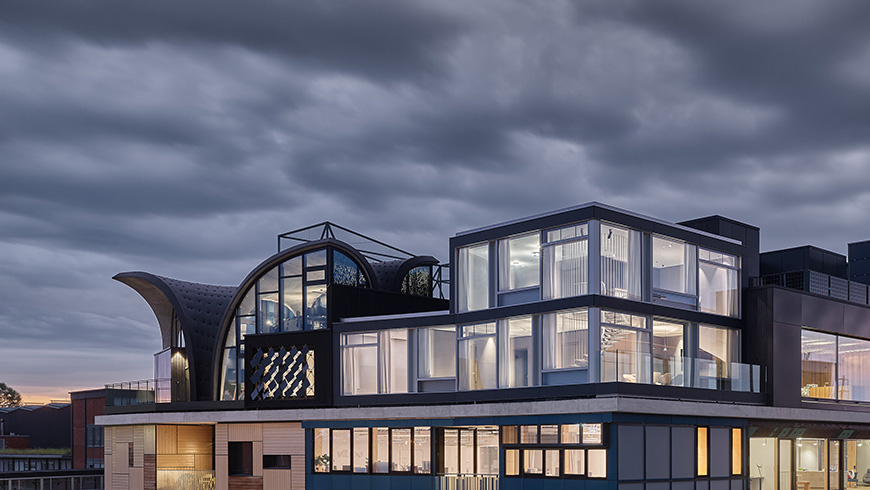STEP2: New NEST unit inaugurated
New technologies for resource-efficient construction developed to market readiness
A digitally manufactured staircase that winds its way up to the second floor. A wafer-thin, perforated concrete ceiling that absorbs sound. Floor and wall materials made from recycled waste. The latest unit in the NEST research and innovation building at Empa is a beacon for material-saving and energy-efficient construction technologies. The STEP2 unit was officially opened on August 29, 2024.

In Switzerland, the construction sector consumes by far the most raw materials, generates the largest amount of waste and is responsible for a third of all CO2 emissions. With the modular research and innovation building NEST, Empa, together with more than 150 partners from research, industry and the public sector, has been working for over eight years to ensure that new technologies and materials for resource-efficient construction are developed to the point where they can make the leap into the market.
The most recent example of this is the STEP2 unit, which is being officially opened today. The two-story building module at the very top in the south-east corner of NEST combines a range of innovations, all of which are aimed at reducing materials and energy consumption and promoting the circular use of our resources. "At the same time, it is very important to us that we develop solutions that are marketable and actually have a future in the construction industry," says Enrico Marchesi, Innovation Manager at NEST. In a three-way team with the main partner BASF and the architecture firm ROK, the NEST team at Empa therefore scrutinized every idea for market relevance and developed real business cases with the other partners. "For us as the main partner, the STEP2 unit serves to incorporate BASF's broad chemical expertise into tangible, new and sustainable solutions for the construction sector in collaboration with the other partners. We are convinced that true, marketable innovation can only emerge when players along the entire value chain work together as equals," says Olivier Enger, Senior Innovation Manager at BASF.
Accordingly, the team pursued a co-creation approach from the outset – which is rather unusual for a construction project. "In practice, a construction project like this requires the closest possible collaboration between all parties involved, from conception to realization," says architect Silvan Oesterle from ROK. Even before the first sketch was drawn up, all the relevant stakeholders sat together and joined in the discussions. "This was the only way we could ensure that we took all important aspects into account when integrating new technologies into the construction project," explains Oesterle, who calls this concept "integrated architectural development". The results of this approach are functionally and aesthetically unique building innovations that can now be found in the new NEST unit STEP2.
Multifunctional and resource-optimized ceiling
When you enter STEP2, the ceiling is the first thing that catches the eye. Designed as a ribbed filigree ceiling, it allows spans of up to 14 meters and is therefore particularly suitable for office and high-rise construction. The ceiling was developed by the architectural firm ROK together with the engineering firm WaltGalmarini and Stahlton. With the help of specially developed digital planning methods and 3D-printed formwork for the prefabricated elements, it was possible to reduce both the material costs and CO2 emissions by around 40% compared to a concrete flat slab with the same span. In addition to its structural function, the ceiling also fulfils other tasks: Integrated, 3D-printed boxes filled with a clay foam from BASF for sound insulation ensure pleasant room acoustics, despite the reverberant surface. The ceiling also serves as a thermal storage mass, thus equalizing the room temperature and is an important part of the unit's energy concept.
Digitally manufactured concrete staircase
The second floor of the unit is accessed via a curved concrete staircase with the evocative name Cadenza, which forms the symbolic backbone of the building. For the staircase, the team led by the Chair of Digital Building Technologies at ETH Zurich and the architecture firm ROK utilized the full potential of computer-aided design and 3D printing. The 17 steps were manufactured using a single reusable 3D-printed formwork, which allows for a complex and extremely material-reduced shape. The pretensioning technology of the Empa spin-off re-fer, which is based on a shape memory alloy, fixed the steps that were threaded onto each other. The expertise of the former BASF subsidiary Forward AM and New Digital Craft in the field of materials and 3D printing of the formwork, as well as the precast concrete parts manufacturer SW Umwelttechnik and the engineering firm WaltGalmarini, also contributed to the realization of the eye-catching component. Together, they have developed a ready-to-use solution for individual construction projects that is not only suitable for customized concrete staircases, but also contributes to efficient and high-performance design solutions in general thanks to digital planning and production.
Holistic energy concept and adaptive façade
The STEP2 unit's other areas of innovation relate to energy management and the building envelope. The engineering firm WaltGalmarini has developed a comprehensive energy and comfort concept for the unit. The façade is the central element when it comes to optimizing the indoor climate and simultaneously increasing the building's energy efficiency. A new double skin façade developed by Aepli Metallbau with integrated shading and controlled natural ventilation is used. The façade itself is a test and development platform: Individual modules can be replaced over the coming years with little effort, allowing new technologies to be installed. In the first phase, for example, a window element from New Digital Craft with an integrated, 3D-printed structure will be used to provide shading adapted to the sun's path. To achieve this, BASF introduced innovative 3D printing materials in the field of digital production technologies, which were also used to print the staircase formwork.
From waste to raw material – recycling instead of disposal
Based on the principles of upcycling, BASF and its partners have developed processes and materials to create high-performance surface coverings from waste materials. The combination of existing processing technologies with new binder technology and (residual) raw materials makes it possible to create three-dimensional wood fiber boards combined with textile waste and coffee grounds through thermoplastic shaping. This was used to produce customized wall panels for the unit. The wall panels as well as the floor panels were made from recycled denim fibers, used paper cups and coffee grounds with the help of an innovative binding agent and high-performance coatings. For the kitchen area, a new binding agent was also used in standard processes to produce durable, high-quality furniture surfaces with coffee grounds. The use of these, otherwise unused, renewable materials not only reduces the demand for new raw materials, but also reduces greenhouse gas emissions. BASF materials were also used for the levelling as well as the thermal and acoustic insulation of the subfloor, a hollow floor construction. A sprayable, non-combustible clay foam was used for the first time.
STEP2 – a true innovation environment
STEP2 is intended as a co-creation platform and innovation workshop. From now on, the unit will serve as a workplace for BASF's Scouting & Academic Collaborations team led by Olivier Enger. BASF and Empa have maintained a strategic partnership for several years; the team has been based on the Empa campus ever since. Olivier Enger is convinced: "In NEST, we are at the threshold between research and industry and can contribute a great deal with our expertise to successfully bridge the gap between the laboratory and the market."
STEP2 website with detailed information on the innovation objects.
A comprehensive press kit can be found here.
NEST is the modular research and innovation building of the Swiss research institutes, Empa and Eawag. It was completed in 2016 and is located on the Empa campus in Dübendorf. More than 150 partners from research, industry and the public sector work closely together. At NEST, they validate new technologies and construction concepts under real-world conditions, further develop and demonstrate them in everyday use. As a result, innovative construction and energy technologies can enter the market much faster. nest.empa.ch
-
Share







